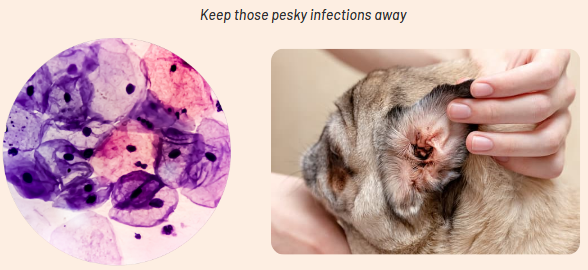Ear Infections: What you need to know

Does your dog love splashing in puddles, rolling in the grass, or shaking their fluffy ears in pure joy? While these are some of the best parts of having a pup, they can also lead to a common and frustrating issue: ear infections.
Ear infections are especially prevalent in dogs with floppy ears, hairy ear canals, or those prone to allergies. Breeds like Poodles, their crosses, and dogs with sensitive skin often deal with this problem. But don’t worry—we’re here to break down the causes, diagnosis, treatment, and prevention of ear infections so you can help your furry friend feel their best!
Let’s dive into the signs, solutions, and why proper care is key to keeping ear infections at bay.
What causes ear infections:
- Most ear infections aren’t contagious. They happen when too many bacteria and yeast grow in the warm, moist environment of the ear canal
- The only contagious ear infection is caused by ear mites, but it’s rare and can be treated with the same stuff we use for fleas and ticks
How we figure out what’s going on:
- When your dog has ear trouble, we’ll take a swab and check it out under a microscope. This helps us see if there’s an infection, what kind it is (yeast or bacteria), and how bad it is
- Then, we give a tailored treatment plan. That way, we’re targeting the problem directly and giving your pet the best shot at getting better
Why follow up visits are important:
After about two weeks of treatment, we’ll check things again to make sure the infection’s gone. Sometimes it looks better, but there might still be some pesky yeast hanging around. If we stop treatment too soon, the infection can come back and cause a lot of frustration for you and your furry friend.
Prevent future ear troubles:
- For dogs prone to ear infections, we’ll work on a plan to keep them at bay. This might include regular cleaning, avoiding water in the ears, or managing any underlying allergies
- We might also recommend keeping the hair around the ears short, but we won’t pluck it out unless your dog is sedated or under anaesthesia. It’s super painful otherwise!
Now let’s break down the importance of cytology in diagnosing and treating ear infections in dogs, why it’s done and it’s long term benefits.
Why cytology is important:
Diagnosis: cytology involves examining a sample of ear discharge under a microscope. This helps identify if there is an infection, what type it is and how severe it is. This information is crucial for proper treatment.
Tailored treatment: knowing the specific type and severity of the infection allows us to prescribe targeted medication. Different infections require different treatments.
Monitoring progress: cytology isn’t just a one-time thing. It’s done initially to diagnose the infection, but is also repeated after treatment to see how well it’s working; this helps our vets to adjust the treatment plan as needed.
Why we do cytology:
Preventing misdiagnosis: ear infections can have similar symptoms, but different causes. Cytology helps distinguish between them
Comprehensive care: in addition to cytology we provide guidance on preventative measures, ongoing monitoring and addressing any underlying issues contributing to the infection
Long term benefits:
Effective treatment: by accurately diagnosing the type and severity of the infection, cytology helps ensure that treatment is successful in eliminating the infection
Preventing recurrence: properly treated infections are less likely to come back. By monitoring progress with follow-up cytology, we are able to confirm the infection is fully resolved, reducing the risk of recurrence
Improved quality of life: chronic or recurrent ear infections can be painful and frustrating for dogs. By effectively managing and preventing them, cytology helps improve your dogs comfort and overall well-being
By staying on top of your dog’s ear health and following our advice, we can keep those pesky infections away and keep your furry friend feeling their best.
| Tags:Ear Infections |
&geometry(180x112))







